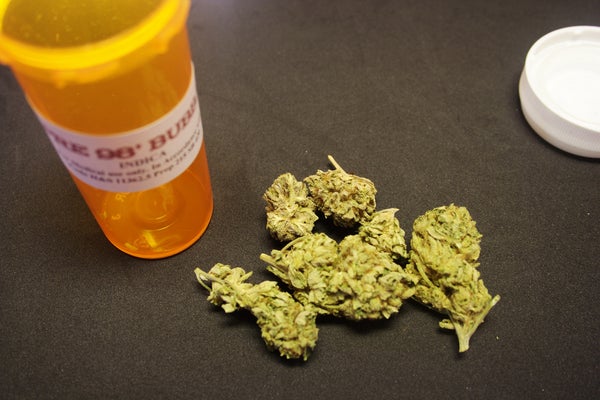This article was published in Scientific American’s former blog network and reflects the views of the author, not necessarily those of Scientific American
Debate over whether pot is a gateway drug that leads to more serious abuse problems—think heroin or cocaine dependence—has raged on seemingly forever. But what if the gate swings the other way? What if the marijuana plant contains chemicals that might help a user avoid or get off the hard stuff?
The Society for Neuroscience’s gargantuan annual fall gathering last week in San Diego, which draws an attendance each year in the tens of thousands, witnessed presentations that suggest the cannabis plant could become a source of drugs for combating addiction.
At the meeting, a group from the Scripps Research Institute in La Jolla, Calif., reported on preliminary research showing that a non-psychoactive marijuana constituent, cannabidiol, can quell urges for cocaine in rats trained over three months to compulsively crave a drug. Researchers allowed rats to dose themselves at will with cocaine until they became addicted. At the end of the period, they gave some of the animals transdermal patches that provided an infusion of cannabidiol. Rats that received the patches reduced cocaine intake, whereas the ones that didn’t continued to consume as much cocaine as before. Other researchers—from Miguel Hernandez University in Spain—reported on an initial study showing that cannabidiol reduced alcohol consumption, as well as the desire to drink and any impulse toward relapse.
On supporting science journalism
If you're enjoying this article, consider supporting our award-winning journalism by subscribing. By purchasing a subscription you are helping to ensure the future of impactful stories about the discoveries and ideas shaping our world today.
Another possible measure discussed at the meeting would steer pain sufferers away from opioids by recruiting the signaling system in the brain that is triggered by marijuana, and by the pot-like chemicals (endocannabinoids) that the body produces on its own. A chemical in pot, tetrahydrocannabinol (THC), can alleviate pain but it also makes the user high by interacting with a particular docking site, the CB1receptor, on brain cells. Scientists from Indiana University found a possible way to treat intransigent neuropathic pain—the kind produced by nerve damage—by using a molecule that enhances the effects of endocannabinoids. The result was long-lasting pain relief without intoxication. Another presentation came from Abide Therapeutics, a San Diego-based biotech company, which showed that a drug that raises levels of an endocannabinoid, 2-AG, might help treat chronic pain.
Marijuana is chemically complex, and the plant’s therapeutic potential comes freighted with its own paradoxical entanglements. Pot ingredients may reduce cravings for some drugs, for example, but they may also produce dependence among teenagers. At the conference, scientists from the University of California, Los Angeles discussed early research, which found that behavioral therapy techniques that tamp down negative emotions might be effective in reducing cravings for marijuana. In attempts to find out what helps and what doesn’t, scientists who research the benefits and perils of cannabis still face enormous challenges in working with the plant, despite the growing trend toward legalization. Margaret Haney, a professor of neurobiology at Columbia University Medical Center (as well as director of Columbia’s marijuana research laboratory and co-director of its substance use research center), told an SFN press conference that “our scientific understanding of the therapeutic potential of the marijuana plant is really in its infancy.”
Haney described continuing difficulties in conducting research on the plant. “Even cannabidiol, which has absolutely no psychoactive or abuse-related effects, [must be treated] like it’s heroin and it’s locked up in a triple drug-safe room. The regulations make studying the plant and its components extremely tricky.”
“The FDA (Food and Drug Administration) and the DEA (Drug Enforcement Administration) are pretty fierce,” Haney said. I think everybody—no matter where you stand in this medical marijuana discussion—everybody agrees we need research because society has moved ahead. [Users are] taking any combination of marijuana and believing that it’s curing 96 ailments. We need research on this, and it’s extremely difficult. Nothing has loosened up, and I’ve been studying it for 20 years.”
“It’s been very difficult to be a cannabis researcher and see society move ahead with no input from the scientific community. There’s been very little consideration of science on this topic,” Haney added. “I’m very concerned that the whole country has decided to believe the medical properties of marijuana, [and] I believe there are some, but we have to decide and test for which indication and under what conditions. It’s just an open-door policy and [people] are being swayed by marketers. Marketers are telling patients what kind of cannabis is good for PTSD vs. migraines, and that’s not based on anything.”
